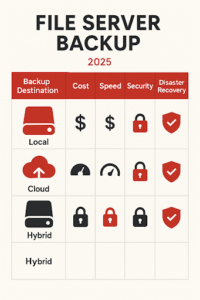
In today’s digital landscape, our data is arguably our most valuable asset. From customer records and financial documents to proprietary designs, this information fuels our operations and drives our success. But what happens if it suddenly vanishes?
Hardware failures, cyberattacks, human error, or even natural disasters can strike at any moment. Losing critical data can halt business operations, damage our reputation, and lead to significant financial costs. This is where a robust file server backup strategy becomes not just important, but absolutely essential for our business survival.
In this comprehensive guide, we will dive deep into file server backup. We will explore the different types of backups, examine the best places to store your valuable data, and outline the key steps to build a resilient and effective backup system. Our goal is to equip you with the knowledge to safeguard your files, ensure business continuity, and gain true peace of mind. We will help you understand how to never lose a file again.
Why File Server Backup is Non-Negotiable for Business Survival
The concept of a file server backup is straightforward: it’s the process of creating copies of the data stored on your file servers and storing them in a separate, secure location. This might seem like a basic IT task, but its importance cannot be overstated. In an era where data is increasingly seen as a business’s most valuable asset, protecting it is paramount.
Consider the potential fallout from data loss. Businesses are vulnerable to catastrophic events and natural disasters such as earthquakes, floods, and fires, which can instantly wipe out physical infrastructure. Beyond acts of nature, human error—accidental deletion, misconfiguration, or even a spilled coffee—remains a leading cause of data loss.
Then there are the malicious threats: cyberattacks, including ransomware, are growing in sophistication and frequency. We know that in 30% of ransomware attacks where data was encrypted, data was also stolen, compounding the damage. Without a reliable backup, such an incident can lead to irreversible data loss, prolonged downtime, and severe financial and reputational consequences.
The financial impact of downtime alone is staggering. Studies consistently show that every hour a business is offline due to data loss or system failure can cost tens of thousands of dollars, sometimes even more, depending on the industry and size of the operation. Beyond the immediate financial hit, there’s the long-term damage to your brand and customer trust. If clients can’t access your services or their data, they’ll quickly look elsewhere.
Furthermore, regulatory compliance is a critical driver for robust backup strategies. Many industries are subject to strict data retention and protection regulations, such as GDPR, HIPAA, and SOX. Non-compliance can result in hefty fines, legal battles, and a tarnished reputation. A well-implemented file server backup strategy is a cornerstone of meeting these compliance requirements, ensuring data integrity, availability, and auditability. It’s not just about recovering from disaster; it’s about proactively building resilience into your operations.
Choosing Your Backup Method: Full, Incremental, and Differential
Understanding the different types of backups is fundamental to designing an efficient and effective file server backup strategy. Each method offers distinct advantages in terms of storage space, backup time, and recovery speed.
- Full Backup: This is the most comprehensive type of backup. A full backup copies all selected data from your file server, regardless of whether it has changed since the last backup.
- Pros: Simplest to restore, as all data is contained in a single backup set.
- Cons: Requires the most storage space and takes the longest to complete, making it less suitable for frequent execution on large datasets.
- Incremental Backup: After an initial full backup, an incremental backup only copies data that has changed since the last backup of any type (full or incremental).
- Pros: Consumes the least amount of storage space and is the fastest backup method.
- Cons: Restoration can be complex and time-consuming, as it requires the last full backup plus all subsequent incremental backups in the correct order. If one incremental backup is missing or corrupted, the entire restore chain can break.
- Differential Backup: Similar to incremental, a differential backup also starts with an initial full backup. However, it copies all data that has changed since the last full backup.
- Pros: Faster than full backups and more reliable for restoration than incremental backups, as it only requires the last full backup and the latest differential backup.
- Cons: Requires more storage space and takes longer than incremental backups, as the amount of data copied grows with each differential backup until the next full backup.
Many modern backup solutions also offer Image-Based Backups. This method captures an entire snapshot of a server, including the operating system, applications, and all data, often as a single file. This is particularly useful for bare-metal recovery, allowing you to restore an entire system to a previous state, even to different hardware. While image-based backups can be large, they offer unparalleled recovery speed for entire systems.
The choice among these methods often depends on your Recovery Point Objective (RPO) – how much data you can afford to lose – and your Recovery Time Objective (RTO) – how quickly you need to recover. A common strategy is to combine these types, for example, performing a weekly full backup, daily differential backups, and more frequent incremental backups for highly critical data. This balances efficiency with recoverability.
Where to Store Your Backups: Local, Cloud, and Hybrid Models
Once you’ve decided on your backup method, the next critical decision is where to store your valuable data. The choice of backup destination significantly impacts accessibility, security, cost, and disaster recovery capabilities. We typically categorize backup destinations into three main models: local, cloud, and hybrid.
- Local Storage: This involves storing backups on physical media located within your premises. Common local storage options include external hard drives, Network Attached Storage (NAS) devices, and dedicated backup appliances.
- Pros: Fastest backup and recovery speeds due to direct network access. Offers complete control over your data and hardware. Can be cost-effective for smaller data volumes.
- Cons: Vulnerable to local disasters (fire, flood, theft) that could destroy both primary data and backups. Requires manual management and physical security. Scalability can be limited and costly.
- Cloud Storage: This model involves sending your backups to a remote data center operated by a third-party cloud service provider (e.g., AWS, Azure, Google Cloud, specialized backup providers).
- Pros: Excellent for offsite backup, protecting against local disasters. Highly scalable, allowing you to pay only for the storage you use. Accessible from anywhere with an internet connection, facilitating remote recovery. Cloud providers often offer robust security measures and redundancy.
- Cons: Backup and recovery speeds are dependent on internet bandwidth. Ongoing costs can accumulate, especially for large data volumes or frequent data retrieval. Data privacy and compliance concerns need careful vetting of the provider.
- Hybrid Backup: This strategy combines the benefits of both local and cloud storage. Typically, data is first backed up locally for fast recovery of common incidents, and then a copy of that local backup (or a subset of critical data) is replicated to the cloud for disaster recovery and offsite protection.
- Pros: Offers the best of both worlds: rapid local recovery for everyday issues and robust offsite protection against major disasters. Provides redundancy and flexibility.
- Cons: More complex to set up and manage, requiring coordination between local and cloud components. Can be more expensive than a single-destination strategy due to managing two distinct storage environments.
The 3-2-1 rule states that every local backup should be accompanied by an offsite backup. This widely accepted best practice recommends having at least three copies of your data, stored on two different types of media, with one copy kept offsite. A hybrid approach is often the most effective way to achieve this rule, providing both speed and comprehensive protection. When evaluating options, consider your RTO and RPO, budget, data volume, and regulatory requirements.
Building a Resilient File Server Backup Strategy
Developing a robust file server backup strategy goes beyond simply choosing a method and a destination. It requires a comprehensive approach that integrates automation, regular testing, and meticulous documentation. A truly resilient strategy ensures that your data is not only backed up but also reliably recoverable when you need it most.
Automation is key to consistency and minimizing human error. Manual backups are prone to being forgotten, misconfigured, or interrupted. Implementing automated backup schedules ensures that your data is regularly copied without constant oversight. This frees up IT staff to focus on more strategic tasks and guarantees that backups occur even outside of business hours when server loads are typically lower.
Scheduling should align with your business’s data change rate and RPO. For highly dynamic data, daily or even hourly backups might be necessary. Less critical data might suffice with weekly or even monthly backups. The goal is to minimize the amount of data that could be lost between backup cycles.
Perhaps the most overlooked, yet critical, step in any backup strategy is testing restores. A backup is only as good as its ability to be restored. Regularly performing test restores, ideally to a separate, isolated environment, verifies the integrity of your backup data and the functionality of your recovery process. This “fire drill” approach helps identify potential issues before a real disaster strikes, ensuring that your RTOs can actually be met. Testing also familiarizes your team with the restoration procedures, reducing panic and errors during a crisis.
Documentation of your backup and recovery procedures is essential. This includes details on what data is backed up, where it’s stored, the backup schedule, retention policies, and step-by-step instructions for restoration. Comprehensive documentation ensures that anyone on your IT team (or even a new hire) can execute a recovery, even if the primary person responsible is unavailable.
Developing a comprehensive plan often involves leveraging professional File server backup solutions to ensure all bases are covered. These specialized services can provide the expertise, technology, and infrastructure needed to implement and manage a truly resilient backup strategy, custom to your specific business needs and compliance requirements.
Step-by-Step: Implementing Your First File Server Backup
Implementing your first file server backup can seem daunting, but by breaking it down into manageable steps, you can establish a solid foundation for data protection.
- Identify Critical Data: Begin by inventorying all data on your file server. Categorize it by criticality and sensitivity. Which files are absolutely essential for business operations? Which are subject to regulatory compliance? This prioritization will guide your backup frequency and retention policies.
- Choose Backup Type: Based on your RPO, RTO, and data volume, select the appropriate backup methods (full, incremental, differential, or image-based). For instance, you might opt for a weekly full backup combined with daily incremental backups for frequently changing data.
- Select Destination(s): Decide on your storage location(s) – local, cloud, or a hybrid approach. Consider factors like budget, internet bandwidth, and physical security. Remember the 3-2-1 rule: at least one copy offsite.
- Configure Software: Install and configure your chosen file server backup software. This will be the engine of your backup strategy. Ensure it supports your chosen backup types and destinations, and has features like encryption, compression, and scheduling.
- Set Schedule: Configure your automated backup schedules within the software. Align these with your identified data criticality. Most organizations find that backups are best performed during off-peak hours to minimize impact on network performance.
- Monitor and Test: Once your backups are running, establish a routine for monitoring their success. Check logs regularly for errors or warnings. Crucially, perform regular test restores to verify that your data is recoverable and that your recovery process works as expected. This step is non-negotiable for ensuring the integrity of your backup strategy.
Securing Your Backups: Encryption and Access Control
Having backups is one thing; ensuring they are secure is another. Your backup data is a prime target for cybercriminals, as it represents a complete copy of your valuable information. Therefore, robust security measures are paramount.
Encryption is a fundamental layer of defense. It should be applied in two key stages:
- Encryption in-transit: This protects your data as it travels from your file server to the backup destination (e.g., over your network to a NAS, or over the internet to the cloud). Secure protocols like SSL/TLS should be used for data transfer.
- Encryption at-rest: This protects your data once it has reached its storage location. Your backup software or storage solution should encrypt the data before it’s written to disk. This ensures that even if an unauthorized party gains access to your backup media or cloud storage, the data remains unreadable without the decryption key. Strong encryption standards, such as AES-256, are recommended.
Access control policies dictate who can access, modify, or delete your backup data. Implement the principle of least privilege, meaning users and systems should only have the minimum necessary permissions to perform their tasks. This includes:
- Strong authentication: Use complex passwords, multi-factor authentication (MFA), and regularly review access credentials.
- Role-based access control (RBAC): Assign permissions based on job roles rather than individual users.
- Network segmentation: Isolate your backup network or storage from your primary production network to limit potential attack vectors.
Immutable backups are a powerful defense against ransomware and accidental deletion. Immutability means that once a backup is created, it cannot be altered or deleted for a specified period. This “write-once, read-many” approach ensures that even if ransomware encrypts your live data and then attempts to encrypt or delete your backups, the immutable copies remain untouched, providing a clean recovery point.
Finally, don’t overlook physical security for local backup media. Store external drives or tapes in a locked, secure location, ideally offsite, to protect against theft or environmental damage. For cloud backups, ensure your provider has strong physical security measures for their data centers. Combining these layers of security creates a robust defense for your critical backup data.
The Role of Software and Compliance in Modern Backups
Modern file server backup solutions are far more sophisticated than simple copy-paste operations. They leverage advanced software capabilities to automate processes, optimize storage, and provide granular control over data recovery. Simultaneously, navigating the complex landscape of data retention and compliance regulations is a non-negotiable aspect of any robust backup strategy.
Backup software acts as the central nervous system of your data protection efforts.
- Backup automation ensures that backups run consistently without manual intervention, reducing the risk of human error and missed schedules.
- Centralized management provides a single pane of glass to oversee all backup jobs, monitor status, and troubleshoot issues across multiple file servers or locations.
- Reporting and alerts keep you informed about backup success or failure, allowing for proactive intervention if problems arise.
- Granular recovery is a crucial feature, enabling you to restore individual files, folders, or specific application data without having to restore an entire server or large dataset. This significantly speeds up recovery for common data loss scenarios.
- Bare-metal recovery allows for the restoration of an entire system, including the operating system, applications, and data, to new hardware if a server completely fails.
Effective backup software streamlines these processes, making data protection more efficient and reliable.
Key Features to Look for in File Server Backup Software
When evaluating file server backup software, look for solutions that offer a comprehensive set of features to meet your organization’s specific needs for efficiency, reliability, and security.
- Scalability: The software should be able to grow with your data. As your file server data expands, the solution should seamlessly handle increased volumes without performance degradation or requiring a complete overhaul.
- Cross-platform support: If your environment includes a mix of operating systems (e.g., Windows, Linux, macOS servers), the software should support all of them to provide a unified backup solution.
- Deduplication: This feature identifies and eliminates redundant data blocks across your backups, significantly reducing storage space requirements and speeding up backup times.
- Compression: Compressing backup data further reduces storage footprint and network bandwidth usage during transfers.
- Bandwidth throttling: This allows you to limit the amount of network bandwidth that backup operations consume, preventing them from saturating your network during business hours.
- VSS (Volume Shadow Copy Service) support: For Windows servers, VSS integration is crucial. It enables the software to create consistent snapshots of open files and applications, ensuring data integrity during the backup process without interrupting ongoing operations.
- Flexible scheduling and retention policies: The ability to customize backup schedules (e.g., hourly, daily, weekly) and define how long different versions of data are retained is essential for meeting RPOs and compliance requirements.
- Reporting and alerting: Automated reports on backup status and real-time alerts for failures or issues are vital for proactive management.
- Encryption: As discussed, robust encryption for data in-transit and at-rest is non-negotiable for security.
- Ease of use and intuitive interface: A user-friendly interface simplifies configuration, management, and recovery, reducing the learning curve and potential for errors.
- Support for various backup destinations: The software should support your chosen local, cloud, or hybrid storage options.
Meeting Compliance and Data Retention Requirements
Beyond technical features, compliance and data retention are critical considerations for file server backups. Data retention policies dictate how long certain types of data must be kept, often driven by legal, regulatory, or business requirements.
- Data lifecycle management: This involves understanding the journey of your data from creation to archival or deletion. Your backup strategy must align with this lifecycle, ensuring that data is retained for the appropriate duration.
- Archiving vs. backup: It’s important to distinguish between backups (copies for recovery from recent data loss) and archives (long-term storage of data that is no longer actively used but must be retained for compliance or historical purposes). While backup solutions can sometimes facilitate archiving, dedicated archiving solutions are often better suited for long-term, immutable storage with specific search and e-findy capabilities.
- Legal holds: In the event of litigation or investigations, specific data may need to be placed on a “legal hold,” meaning it cannot be deleted, even if its standard retention period has expired. Your backup system should support the ability to manage such holds.
- Audit trails: To demonstrate compliance, your backup solution should provide detailed audit trails of all backup and restore activities, including who accessed what data and when.
- Industry regulations: Different sectors have specific data protection mandates. For example:
- GDPR (General Data Protection Regulation): Requires clear data retention periods, the right to be forgotten, and robust security for personal data.
- HIPAA (Health Insurance Portability and Accountability Act): Mandates strict security and privacy rules for protected health information (PHI) in the healthcare sector.
- SOX (Sarbanes-Oxley Act): Affects publicly traded companies and requires strong internal controls over financial reporting, which includes data integrity and availability.
Failing to meet these requirements can lead to significant penalties, reputational damage, and legal repercussions. Therefore, your file server backup strategy must be designed with these regulatory frameworks in mind, ensuring that your data protection efforts are not just technically sound but also legally compliant.
Frequently Asked Questions about File Server Backup
How often should we perform file server backups?
The frequency of file server backups depends directly on how often your data changes and your Recovery Point Objective (RPO) – the maximum amount of data you can afford to lose. For highly critical data that changes constantly (e.g., transaction logs, active databases), hourly or even continuous data protection (CDP) might be necessary. For general user files that change frequently but aren’t as time-sensitive, daily backups are often sufficient. Less critical or static data might be backed up weekly or monthly. The key is to balance the risk of data loss with the resources (storage, bandwidth, time) required for more frequent backups.
What is the most important step in any backup strategy?
While every step is crucial, the most important step in any backup strategy is regularly testing your restores. A backup is useless if it cannot be restored successfully when needed. Testing validates the integrity of your backup data, confirms that your recovery procedures work, and identifies any potential issues before a real disaster strikes. It ensures that your Recovery Time Objective (RTO) – how quickly you can get back up and running can actually be met. Think of it as a fire drill for your data; you wouldn’t want to find the fire extinguisher empty during a real fire.
Is cloud backup a secure option for sensitive business data?
Yes, cloud backup can be a very secure option for sensitive business data, often offering security advantages over traditional on-premise solutions, provided you choose the right provider and configure it correctly. Reputable cloud backup providers invest heavily in security measures, including physical security of data centers, advanced encryption (in-transit and at-rest), robust access controls, intrusion detection, and compliance certifications (e.g., SOC 2, ISO 27001). However, the responsibility for data security is shared. You must ensure you use strong passwords, multi-factor authentication, client-side encryption (if available), and understand your provider’s security policies and compliance adherence. Always vet your cloud provider thoroughly before entrusting them with sensitive data.
Conclusion: From Data Protection to Business Advantage
In today’s volatile digital landscape, a robust file server backup strategy is no longer a luxury but a fundamental necessity for business survival and growth. We’ve explored why this is non-negotiable, from mitigating the severe financial and reputational impacts of data loss to ensuring compliance with increasingly stringent regulations.
We’ve dug into the various types of backups—full, incremental, differential, and image-based each offering unique benefits for speed and storage. We’ve also weighed the pros and cons of different storage destinations, from the speed of local solutions to the resilience of cloud and the balanced approach of hybrid models, all while emphasizing the critical 3-2-1 backup rule: three copies, two different media, one offsite.
Building a resilient strategy involves more than just technology; it demands a proactive approach encompassing automation, rigorous testing of restores, and meticulous documentation. The right software, with features like scalability, cross-platform support, deduplication, and encryption, acts as the backbone of this strategy. And crucially, understanding and adhering to data retention policies and industry-specific regulations transforms data protection from a mere technical task into a strategic business advantage.
By implementing these best practices, you move beyond simply protecting your data; you future-proof your operations, ensure seamless business continuity, and gain the invaluable peace of mind that comes from knowing your most critical asset is secure. Don’t wait for a crisis to realize the value of your data. Take proactive steps today to safeguard your file servers, and truly master the art of never losing a file.

A Friendly Guide To The Different Kinds Of Waste

What Foreign Companies Need to Know About Employee Benefits in Mexico

What is an MVP and Why Every Startup Needs One

Accelerating drug discovery through the DEL-ML-CS approach

AI in Marketing Is No Longer a Buzzword — It’s the Strategy

Why the LG 34WQ75C-B UltraWide QHD Curved Monitor is the Ultimate Upgrade for Work and Play?

How to Choose the Right Email Organizer: Features to Look for in 2025

Never Lose a File: The Art of File Server Backup











